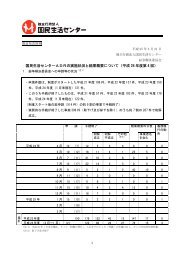FSIS_14-07_Interim4_Redacted_PlusCover.pdf#_ga=1.106999616.330874689
FSIS_14-07_Interim4_Redacted_PlusCover.pdf#_ga=1.106999616.330874689
FSIS_14-07_Interim4_Redacted_PlusCover.pdf#_ga=1.106999616.330874689
You also want an ePaper? Increase the reach of your titles
YUMPU automatically turns print PDFs into web optimized ePapers that Google loves.
_____________________________________________<br />
From: Defibaugh-Chavez, Stephanie - <strong>FSIS</strong><br />
Sent: Monday, October 28, 2013 6:51 PM<br />
To: Green, Alice - <strong>FSIS</strong>; Dessai, Uday - <strong>FSIS</strong><br />
Cc: Robertson, Kis - <strong>FSIS</strong>; Kissler, Bonnie - <strong>FSIS</strong>; Douris, Aphrodite - <strong>FSIS</strong><br />
Subject: RE: Heidelberg Pct Hospitalized by PFGE<br />
I think it’s interesting that although 258 and 45 are highly similar in PFGE pattern, they appear to have vastly different<br />
hospitalization rates (almost double for 45). To me, this particular difference in hospitalization rates indicates the<br />
likelihood of some sort of plasmid that is making some of these strains more virulent than others.<br />
Stephanie Defibaugh-Chávez, Ph.D.<br />
Microbiologist<br />
Science Staff, Office of Public Health Science<br />
Food Safety and Inspection Service<br />
United States Department of Agriculture<br />
202-690-6042 (office)<br />
202-641-5540 (Blackberry)<br />
202-690-6364 (fax)<br />
email: stephanie.defibaugh@fsis.usda.gov <br />
Stay Connected with USDA:<br />
> > > <br />
_____________________________________________<br />
From: Green, Alice - <strong>FSIS</strong><br />
Sent: Monday, October 28, 2013 6:08 PM<br />
To: Dessai, Uday - <strong>FSIS</strong><br />
Cc: Defibaugh-Chavez, Stephanie - <strong>FSIS</strong>; Robertson, Kis - <strong>FSIS</strong>; Kissler, Bonnie - <strong>FSIS</strong>; Douris, Aphrodite - <strong>FSIS</strong><br />
Subject: RE: Heidelberg Pct Hospitalized by PFGE<br />
Hi Uday—<br />
Here is today’s update to the requested information.<br />
Based on Aphrodite’s work last summer, patterns 258 and 45 are the most closely related in the cluster at 99% similar<br />
with one band differing. Patterns 122 and 672 are about 97% similar with one band difference. Pattern 22 is 90% or<br />
less similar to all other patterns.<br />
file:///Z|/All%2020<strong>14</strong>%20FOIA's/01%20-%2050/<strong>14</strong>-<strong>07</strong>/from%20OPHS/<strong>14</strong>-<strong>07</strong>/AG/2013%20Foster%20Farms.txt[12/6/2013 3:31:24 PM]




